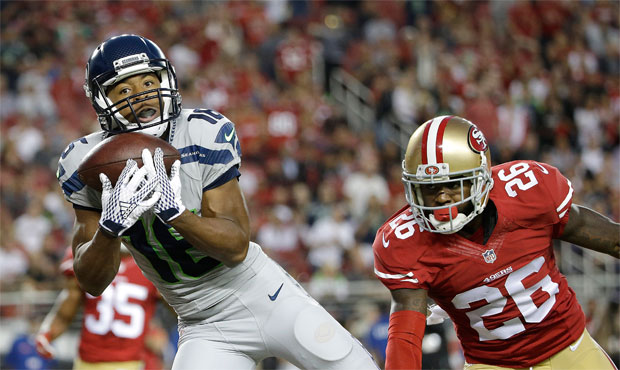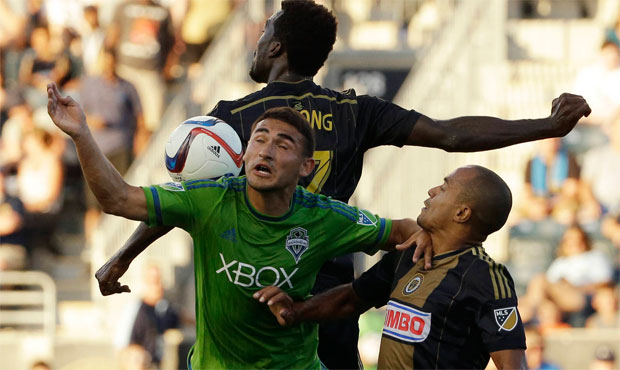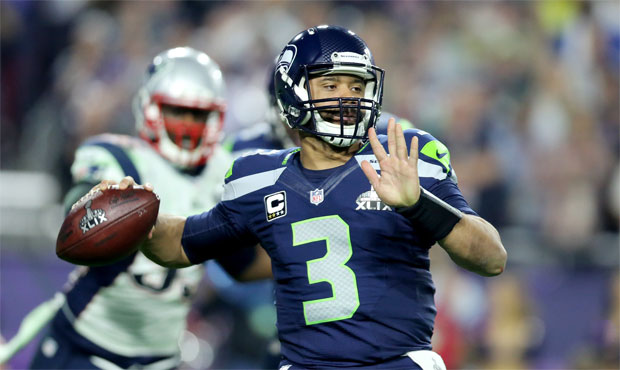Danny Dave and Moore
Three Things from the Seahawks’ wild-card win over Minnesota
 Seattle held NFL rushing champ Adrian Peterson to just over 2 yards per carry in two meetings this season. (AP)
Seattle held NFL rushing champ Adrian Peterson to just over 2 yards per carry in two meetings this season. (AP)
The Seahawks showed Sunday that any team that wants to win the NFC this year is going to have to pry the conference out of Seattle’s cold, dead hands.
And as cold as the Seahawks’ fingers were on Sunday, they weren’t dead. Only mostly dead when Blair Walsh lined up for that point-blank field goal attempt. But as Seattle survives to play again, here’s a list of what we learned and what we’re still trying to figure out.
Three things we learned:
1. Don’t draw any conclusions from Seattle’s first-half performance on offense.
Not just by the way the Seahawks’ offense functioned in the first half of the 2015 regular season, but the first half of playoff games. Sunday was Pete Carroll’s 11th playoff game as Seattle’s head coach. It was the fourth time his team was shut out in the first half of a playoff game. Seattle has come back to win two of those four playoff games, beating Green Bay in overtime in last season’s NFC Championship Game and then sneaking out a win in Minnesota on Sunday. Not only that, but the Seahawks had the lead in the final minute of the fourth quarter at Atlanta in January 2013 after trailing 20-0 at halftime. Under Carroll, the Seahawks have scored an average of 9.6 points in the first half of playoff games and 17 points in the second half.
2. This is the best defensive front seven the Seahawks have had under Carroll.
The league’s rushing champ got his second crack in five weeks at the Seahawks, and while Adrian Peterson got almost three times as many carries as he did back in December, he wasn’t any more successful. In fact, he averaged fewer yards per attempt than he did back in that first meeting when he gained 18 yards on eight carries. Not only that, but he lost a fumble Sunday, which was the Vikings’ only turnover. The fact that it was defensive tackle Ahtyba Rubin who recovered that fumble – 13 yards downfield no less – tells you a lot about the pursuit and sideline-to-sideline effort level the Seahawks get even from the big men in the middle of the trenches.
3. Field position has become the biggest predictor of Seattle’s success.
That was the case in the regular-season finale in Arizona when Tyler Lockett’s punt returns kept giving the Seahawks a short porch to Arizona’s end zone. This week, it was Seattle’s inability to control field position that set the Vikings up for success, first with a botched punt and then by failing to advance the ball on offense. Minnesota’s three field-goal drives started – on average – at the Seattle 46. The drive that would have won the game had Walsh made that 27-yard attempt? It started on the Vikings’ 46. Minnesota didn’t have a scoring drive longer than 29 yards in Sunday’s game. Used to be turnovers were the biggest predictor of Seattle’s success. This season, it has been field position.
Three things we’re still trying to figure out:
1. Why is Carroll always neck deep in famously unusual endings?
In college, the Bush Push allowed USC to defeat Notre Dame, the Trojans played a couple of triple-overtime games and it was only Texas’ Vince Young – with an all-time great Rose Bowl performance – that ended their run on top. In Carroll’s six seasons with the Seahawks, Marshawn Lynch has galloped through the Saints on a 67-yard run so exciting it triggered seismic activity near the stadium. They beat the Packers in the NFC Championship in a game Seattle had no business winning only to lose two weeks later when it seemed a Super Bowl victory was all but sealed. And now comes a playoff game in which the Seahawks failed to score for the first three quarters and then sweated out a 27-yard field-goal attempt – a 98-percent certainty in the NFL this year – and had it hook right. It’s remarkable, really, but if there’s any deeper truth here, it’s that while Carroll’s teams blow out opponents from time to time, the Seahawks are almost always hip deep in a dogfight. That explains why this team has lost by 10 or more points only once in the 73 meaningful games it has played since the 2012 regular season began.
2. Do you blame Seattle’s defense for failing to close out Sunday’s game?
On Minnesota’s third chance at a game-winning drive, a defensive pass-interference penalty against strong safety Kam Chancellor and a 24-yard completion to tight end Kyle Rudolph put Minnesota in position to win it. An inexplicable, close-range miss by the Vikings kicker is all that prevented that game from being characterized as a microcosm of this season for a Seattle defense that statistically has been superb yet has given up a fourth-quarter lead in five different games. But let’s look a little closer. Sunday was another example of Seattle’s defense being put in bad positions, whether it was the botched punt in the first quarter, the fact that Minnesota held the ball for 12:57 of the 15 minutes in the first quarter or how Seattle’s offense failed to gain so much as a single first down on either of the two possessions when it had a chance to run out the clock. The league’s top rush defense was just that, holding Peterson to an average of fewer than 2 yards on his 23 carries. Seattle’s secondary allowed only one completion of more than 20 yards the entire game and didn’t give up a scoring drive of more than 30 yards, which means everyone should probably chill on the idea that Seattle’s defense nearly gave away another game.
3. How do you make sense of Seattle’s offensive performance?
It wasn’t good. Russell Wilson threw for 142 yards, the second-lowest passing total in any of the nine playoff games he has played. He only completed 50 percent of his pass attempts and he was picked off. It was also minus-6 degrees Fahrenheit at kickoff, and the fact that he underthrew three deep balls – something that’s a strength of his – leads to the belief that the weather did in fact have an impact upon his ability to grip and/or throw the football. In the running game, Christine Michael looked solid. That’s about the best sign for him right now. He wasn’t spectacular. He didn’t do anything outrageous. He was solid, occasionally explosive and dependable to pick up the 4-yard gain that was there for him. That is a great sign.

























Comments